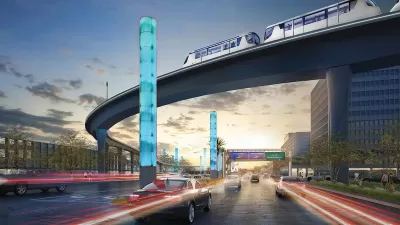Many U.S. airports are in need of significant overhauls, as terminals from the 60s and 70s can't keep up with current demand and expectations. Jad Mouawad explores the renovations and expansions transforming the nation's largest airports.
While airports in Asia and Europe get high marks for amenities and customer service, airports in the United States are being criticized for crumbling terminals, outdated amenities, and crowded areas. In light of these issues, many major American airports, such as Kennedy International, Los Angeles International, and Hartsfield-Jackson Atlanta International, are pouring billions of dollars into rebuilding terminals to accommodate higher traffic, airline mergers, and bigger planes, including the Airbus 380.
While public works projects throughout the country are stalled by political gridlock and budget crises, airport renovations "amount to some of the largest infrastructure projects in the country." As Mouawad explains, "Most airports in the United States are owned by cities or local authorities but are not dependent on taxpayer money to finance themselves and are, therefore, less affected by the current political mood to rein in spending. Instead, they typically finance investments through the revenue they generate, including airline fees, passenger charges and the sale of bonds tied to passenger traffic."
Jerry Orr, the chief executive of Charlotte Douglas International, noted, "Clearly, investment in aviation facilities has lagged the demand...But airports are businesses, and airports need the services that airlines provide."
FULL STORY: Airports Focus on the Ground

Alabama: Trump Terminates Settlements for Black Communities Harmed By Raw Sewage
Trump deemed the landmark civil rights agreement “illegal DEI and environmental justice policy.”

Study: Maui’s Plan to Convert Vacation Rentals to Long-Term Housing Could Cause Nearly $1 Billion Economic Loss
The plan would reduce visitor accommodation by 25% resulting in 1,900 jobs lost.

Planetizen Federal Action Tracker
A weekly monitor of how Trump’s orders and actions are impacting planners and planning in America.

Wind Energy on the Rise Despite Federal Policy Reversal
The Trump administration is revoking federal support for renewable energy, but demand for new projects continues unabated.

Passengers Flock to Caltrain After Electrification
The new electric trains are running faster and more reliably, leading to strong ridership growth on the Bay Area rail system.

Texas Churches Rally Behind ‘Yes in God’s Back Yard’ Legislation
Religious leaders want the state to reduce zoning regulations to streamline leasing church-owned land to housing developers.
Urban Design for Planners 1: Software Tools
This six-course series explores essential urban design concepts using open source software and equips planners with the tools they need to participate fully in the urban design process.
Planning for Universal Design
Learn the tools for implementing Universal Design in planning regulations.
Caltrans
Smith Gee Studio
Institute for Housing and Urban Development Studies (IHS)
City of Grandview
Harvard GSD Executive Education
Toledo-Lucas County Plan Commissions
Salt Lake City
NYU Wagner Graduate School of Public Service





























